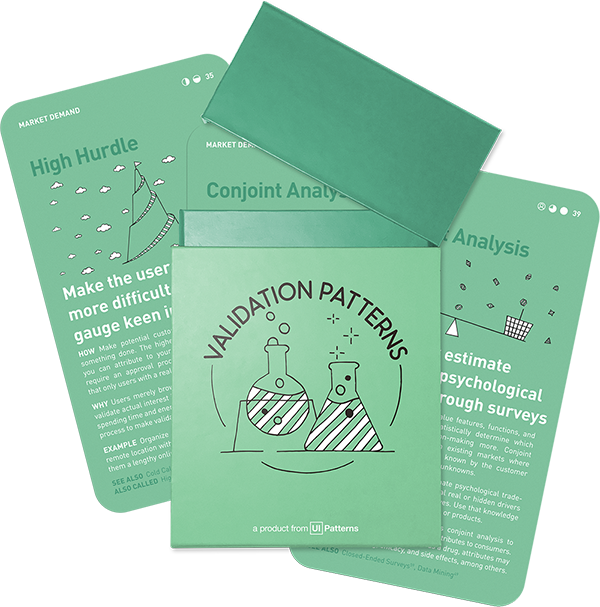See also: Sales Pitch, Sell the Future
Difficulty: Intermediate
Evidence strength
Relevant metrics: Acquisition, Agreed price
Validates: Viability, Desirability
How: Learn whether potential customers want your non-existing product by asking them to sign a contract for using it once it is available. Be very open about the product not existing, but ask for confirmation that users will pay once it is available. If the product isn't developed or if users aren't interested anymore, you (and they) can take it all back without any consequences.
Why: A customer contractually committing to using and paying for your product is a significantly larger validation of willingness to pay than a potential customer verbally expressing interest in your product and agreeing it could be useful. Furthermore, as customers sign an objectively risk-free contract, they commit themselves to invest their mental efforts and their future to your product and pave the way for larger commitments later.
This experiment is part of the Validation Patterns printed card deck
A collection of 60 product experiments that will validate your idea in a matter of days, not months. They are regularly used by product builders at companies like Google, Facebook, Dropbox, and Amazon.
Get your deck!Before the experiment
The first thing to do when planning any kind of test or experiment, is to figure out what you want to test. To make critical assumptions explicit, fill out an experiment sheet as you prepare your test. We created a sample sheet for you to get started. Download the Experiment Sheet.
Make sure that you can both get out
By getting potential customers to sign a contract, you learn whether they actually want your product (that doens’t yet exist) with much more skin in the game than merely asking them. Your objective is to force your experiment participants to conduct actual behavior rather than just expressing their preferences – to do rather than say.
Ask potential customers to sign a contract confirming that they will pay you for your service once it is made available and be very open about the fact that you don’t have it yet. If it turns out the product will not be available or if the customer has lost interested, it’s important that both you and your customer can take it all back without consequences. Still, the commitment and act of signing an actual contract is large proof of willingness to pay.
Product Validation in a B2B setting
In B2B ventures, the process of validation often requires a bit more creativity and finesse compared to B2C due to the complexity of B2B relationships and the longer decision-making processes involved. Effective methods for validating B2B concepts include initiating sales conversations, getting signed letters of purchase intent, and running detailed pilot programs with a handful of customers to understand the challenges and potential improvements of the offering.
After the experiment
To make sure you move forward, it is a good idea to systematically record your the insights you learned and what actions or decisions follow. We created a sample Learning Sheet, that will help you capture insights in the process of turning your product ideas successful. Download the Learning Sheet.
Examples
Ordr.in
To validate whether companies were willing to embed a widget to order lunch to their intranet, the product team pitched the idea to potential customers, getting them to sign a contract clearly stating that no product was yet ready. After 500 contracts were signed, Ordr.in started building the product.
Nike Fit
Nike’s beta test for an AR shoe-sizing app required users to sign a contract, validating their commitment and providing crucial feedback for product refinement.
Source: Nike app uses AR and AI to scan feet for perfect fit
Related plays
- Validating Product Ideas Through Lean User Research by UXmatters
- The Real Startup book by Tristan Kromer, et. al.
- B2B vs B2C Venture Validation: Key Differences and Strategies by bundl

